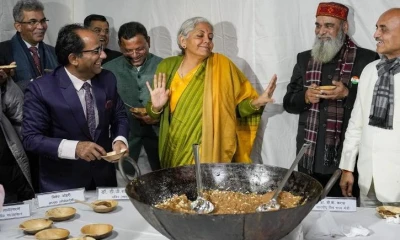Edited by Deepali Verma
The 17th Lok Sabha’s final session is scheduled to commence from January 31 to February 9, with Union finance minister Nirmala Sitharaman presenting the interim budget on February 1. The presentation of the full-fledged Budget for the fiscal year 2024-25 will take place after the formation of the new government following the general elections this year.
Prior to the presentation, a traditional “Halwa Ceremony” will take place. This ceremony, hosted annually and attended by the finance minister in company of other officials, highlights a notable prelude to the Budget presentation.
What is the Halwa ceremony?
The ceremony marks the official initiation of the printing process for the several documents relating to the Budget. The significance of the ceremony lies in the conclusive stages of the extensive budget-making procedure which spans the time period of several months.
The event is a formal ‘send-off’ for the ministry officials as well as the staff engaged in preparing the Union government’s annual financial statement. Subsequently, they enter a designated ‘lock-in’ period, while isolating themselves within the ministry premises and cutting off from their families to respect the confidentiality around the final budget document.
The staff is only permitted to exit the North Block once the finance minister tables the budget in Lok Sabha on February 1.
The ceremonial activity begins in the finance ministry’s basement within Central Delhi, which is home to a dedicated printing press. The proceedings start as the finance minister stirs the ‘halwa’ in a large metal pot or kadhai.
Why are there restrictions before the Budget presentation?
Budget preparation is an extremely confidential process that is carried out by the finance minister in collaboration with the high-ranking officials. Those involved undergo a period of lockdown where they are restricted from using mobile phones until the budget is officially presented. Various entities such as the ministries, states, union territories, defence forces, and other departments, are tasked with preparing estimates. The budget goes to the printing stage once it receives approval from the prime minister.
Beyond the finance minister’s movements within or outside the restricted area that houses the stenographers and officials, surprise visits to the printing press area in the basement of North Block are reportedly conducted by the chief of the Intelligence Bureau.
The families of the quarantined officials have the option to leave a message on a designated number, if there is an emergency. However, direct communication is not permitted. These stringent measures have a history that dates back to a leak that occurred in 1950.
1950 Union Budget leak
There was a breach in the security protocols of this highly classified process in 1950 during John Mathai’s tenure as the finance minister. A segment of the 1950 Union Budget was subjected to a leak when the document’s printing was underway at the Rashtrapati Bhawan. As a response to the aforementioned breach, the printing venue was relocated to a government press on Minto Road. Since 1980, the North Block basement at Delhi’s Secretariat Building has been designated as the permanent location for the budget printing.
Finance minister Mathai, after the leak was facing allegations of serving the interests of higher powers and affluent individuals, had to resign.

















